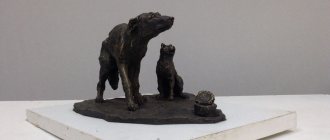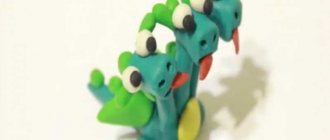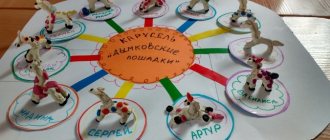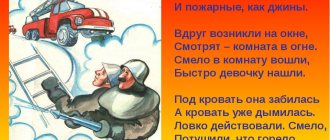Outline of a modeling lesson on the topic: “My Home” (preparatory group)
Productive activity “Modeling” Lesson plan on the topic: “My Home” in the preparatory group Goals: to develop children’s interest in modeling from plasticine;
To develop accuracy and perseverance in children. Objectives: to develop children’s understanding of home, city, native land; consolidate the ability to work in a stack, cut off excess parts of the columns, arrange parts of the building in a certain sequence; cultivate love and respect for your home and city; develop spatial imagination. Materials: stand templates cut out of cardboard (green, yellow), plasticine, stacks, boards for modeling, a ready-made sample of a plasticine house, napkins, a chest with demonstration material (pictures of the city, houses, wooden buildings). Work progress: V. Guys! Let's see what the magic chest has prepared for us today! (I take out photographs of recognizable “attractions” of my hometown) Q. What do you think is shown in the photograph? (children's answers) Absolutely right, these buildings - hospitals, pharmacies, cinemas, train stations - are located in our city. He will build a skyscraper and a stadium right on time. A kindergarten and a hospital, a line of shops. Even a house, I’ll tell you, Where my family lives, (I. Ilkh) V. And what else has our chest prepared for us, let’s see! (I take out pictures and photographs of residential buildings) V. All this was built by people, residents of our city, for you and me. Therefore, guys, we will also build a house for ourselves and our family. (I take out a finished sample of the product from the chest and an image of its step-by-step implementation) Q. For this you will need plasticine and your imagination! Productive activities under the guidance of a teacher. Tell the children that they need to roll a lot of columns, then make them the same length using a stack. Form a base on a template-stand in the form of a rectangle, place doors and windows on them, then assemble the walls of the house. At the same time, place the columns on top of each other. During the formation of the roof, you will also need columns, and each subsequent one should be smaller (a continuation of the wall is made on both sides in the form of a pyramid), after which the ridge is attached and the roof columns are attached to it. Near the house you can invite the children to make a bench or a tree. Outcome of the lesson: examination of buildings, discussion.
Attached files
univerfiles.com
Summary of the modeling lesson “Plasticine Fairy Tale” in the middle group
Marina Loginova
Summary of the modeling lesson “Plasticine Fairy Tale” in the middle group
Summary of the modeling lesson “
Plasticine Fairy Tale ” (
middle group ) Goal: continue to teach children to convey images of their favorite fairy-tale characters modeling , based on the knowledge and experience gained earlier.
Educational: Improve the ability to perform work using the plasticineography , rhythmically pinch off small pieces of plasticine from the main mass , carefully apply them along the contour of the image, smoothly smoothing the surface. Practice choosing the right color, complementing the image with small details.
Developmental: Develop fine motor skills and coordination of movements, emotional responsiveness, imaginative perception, imagination, creativity.
Educational: To cultivate aesthetic taste, a sense of camaraderie and mutual assistance.
Materials: plasticine , boards, stacks, napkins, illustrations from a fairy tale (sample, pictures from a fairy tale for coloring .
Summary of a lesson on modeling topic: Hometown (team work)
Uyimdastyrylgan oku іs - әreketіnіn technology maps Technological map of organized educational activities. Kunі/date: April kunnі/day of week: Top / Group: senior B Bilim take salas / Educational area: Creativity. Bolim / Section: MOLDING. Takyryby / Topic: Hometown. (teamwork) Maksaty / Goal: Teach children how to sculpt a house. Mindetteri / Objectives: developing the skills to create objects from plasticine. Learn to create objects from plasticine consisting of rectangular, square, triangular parts. To develop children's understanding that there are different houses in our city. Strengthen sculpting techniques (pulling, smoothing). Develop figurative ideas and imagination. Cultivate a positive attitude towards your hometown, feel pride in your city. Vocabulary work: Motherland. Equipment: Plasticine, boards, napkins, sample. Bilingual құрауш / Bilingual component: ––––– area Ә reket kezңderi Stages of activity Tarbieshіn әreketі / Actions of the teacher Balalardyn әreketі / Activities of children Esep/accounting + - Uazhdemelik – turtkіlik / Motivational-incentive K The word of joy: We put our hands in a row. It turned out to be a plane! We fly higher, higher. Higher than the house, higher than the roof, the pilot looks happier. Our plane has taken off! They recite the text together with the teacher. Uyimdastyrushylyk - izdenistik / Organizational - search Game moment: The teacher reads the poem: “What do we call Motherland? The land where you and I live.” There are a lot of big and small cities in the world. We live in the city of Pavlodar. In our city there are many one-story and multi-story houses. There are pharmacies, shops, cinemas, etc. What do we see when we walk around the city of Pavlodar? (shops, pharmacies, post office, homes). Poem: To build a new house, They stock up oak planks, Bricks, iron, paint. Nails, tow and putty. And then, then, then. They begin to build a house! Asks the children: - What is needed in order to build a house? Problem situation: Imagine that you are architects. Who knows who architects are? Use your imagination and come up with your own buildings. Where do you start? Examination of a sample: Let's look at the house, its parts: roof, windows, doors, their location. Demonstration of the modeling method: You have cardboard on the tables, you need to draw with a simple pencil the house you want. And then take plasticine of any color and decorate your home. To do this, you need to roll up a sausage from plasticine and attach it to the walls of the house, windows, doors, the “sausages” can be of different colors, then your houses will be bright and beautiful. Physics lesson: “Building a house” 1,2,3,4, they built a house from planks. Windows, doors were opened and they waved through the window! Individual work: During the lesson, monitor the children’s work, provide assistance with advice and instructions. Listen to a poem. Answer questions. Listen to a poem. They answer a problematic question. They look at the sample and name the parts of the house. Perform movements according to the text. Practical work. Reflective - corrective Analysis of children's work. After finishing the work, examine all the crafts, display them, and admire how many houses there are - several streets, a whole city. At the end of the lesson, pass a magic wand around the circle so that the children tell what they liked about the lesson. The teacher praises the children for their efforts. He reads the poem: Don’t look for it on the map among the capitals, Don’t look for it among the resorts and others. Ah, Pavlodar, my native city, You have become a small homeland for me. Ah, Pavlodar, my native city, I walk through life with you. You are my mentor, you are my teacher, I learn many of your lessons. Ah, Pavlodar, my native city, You became the beginning for me. Know that I am sad when I am not with you. They look at the work and share their impressions. Expected result: Know the parts of the house. Be able to sculpt thin flagella by rolling plasticine between your palms. Have – ideas about your homeland.
globuss24.ru
Summary of the open lesson “Fairy tale in modeling” (middle group)
Nina Kachurina
Summary of the open lesson “Fairy tale in modeling” (middle group)
Modeling a hedgehog based on the fairy tale “Puff”
Teach children to sculpt a hedgehog, conveying its characteristic features: elongated nose, paws, needles. Develop children's creativity and thinking.
Reinforce familiar sculpting , rolling between palms, and develop the ability to pull out individual parts from a whole piece of plasticine.
Practice using the technique of pressing small objects into the surface of a sculpted figure. Develop independence, cultivate interest in modeling .
Vocabulary work: needles.
verbal (guessing a riddle, reading a fairy tale )
explanation (what shape is the body, head, legs)
independence of children's work, a surprise moment.
Materials and equipment:
modeling boards , seeds, vermicelli, buckwheat, grass napkin, image of a hedgehog.
Reading fiction fairy tale “Puff”
, talking about the appearance of a hedgehog, its
habitat and feeding methods, looking at illustrations of a hedgehog, guessing riddles.
Relief sculpture “Ancient city, glorious city”
Introduction to the situation:(Children and parents enter the art studio, on the tables there is a ceramic magic plate with a poured apple, plastic plates, plasticine)
Teacher:
“Dear guys and guests, the magic plate continues to introduce us to our beloved city.
Mystery:
“When there was no Russian state yet,
The fires were smoking at dawn.
And before the Moscow heads stood up,
what city………. erected on the Dnieper?
Updating knowledge:
(the conversation is accompanied by a presentation “The city is the key, the city is the shield)
Teacher:
— In those distant times, people kept chronicles. Chronicle is a record of historical events of ancient times by year. And in one of these records there was the first mention of our city - the city: as large cities were called in the old days.
The first mention of Smolensk was in 863 and from that time the age of the city has been counted. And it is written in the chronicle that “This city is great and has many people.”
Our city is located in a convenient location, since the large, full-flowing Dnieper River flows through the city.
The Krivichi lived peacefully: they raised children, farmed, raised livestock, fished, and went hunting. But enemies often attacked the city, burned and robbed houses, and took people into slavery. All buildings were wooden, and even the fortress wall that surrounded and protected the city. Often, after enemy attacks on the city or fires, the walls had to be repaired or rebuilt. And such a wall could not protect the city from attacks. Therefore, they decided to build the fortress wall from stone; it was built for 6 years from 1596 to 1602. The construction of the wall was supervised by the architect Fyodor Kon . The architect is a builder, an architect, he designed the wall. Grateful residents of the city erected a monument in his honor, which is located near the Thunder Tower. The fortress had 38 towers. Through narrow windows - loopholes it was possible to shoot from cannons and rifles. The width of the fortress was such that it was possible to travel in a carriage drawn by three horses. The length of the fortress was 6.5 km. The height of the walls is from 13 to 19 meters. Special cellars were built under the fortress in which gunpowder and cannonballs were stored. An important role was assigned to towers . They stepped forward so that they could see what was happening in front of the wall to the next tower and fired along the wall. Nowadays, only 17 towers remain.
Bubleika Tower , when the enemy approached, noise signals were given - they beat a tambourine. Hence the name.
The fly tower got its name from the fact that it signaled by waving various objects during the day and lights at night.
From the Vodianaya there was a specially dug ditch leading to the Dnieper to fetch water.
in the Porokhovaya .
Kopytenskaya Tower got its name from the clatter of the hooves of livestock that went out to pasture.
The Avraamievskaya Tower was so named because it was located next to the monastery of the same name.
Donets Tower served as a location for the archers, among them there were many Don Cossacks. (opposite the eternal flame).
Veselukha Tower is located in a beautiful picturesque place and delighted and amused the townspeople.
Eagle Tower is located on the highest place with a good view, which is why it received the name of the most vigilant and powerful bird.
The thunder tower moved forward from the wall and seemed to threaten the enemy. From it it was possible to conduct all-round fire from all guns. The tower was like thunder in its power, which is how it got its name.
Search activity:
(Children approach the model of the Smolensk fortress wall and examine it)
Physical school
Difficult situation:
- Let's look at the magic plate, it invites us all to become sculptors and create an exhibition of commemorative plates with the image of Smolensk.
Including the method of action in the child’s system of knowledge and skills:
— take plasticine of the required color and start drawing with it. We pinch off small pieces from the plasticine, apply them to the base and rub them with strokes.
Independent work of children at tables:
- Yes, my dear masters, now you will create a miracle!
(calm folk music and songs about Smolensk sound)
- Get to work.
All children's work is reviewed for everyone's admiration. A surprise moment: the teacher puts a red apple on each saucer.








